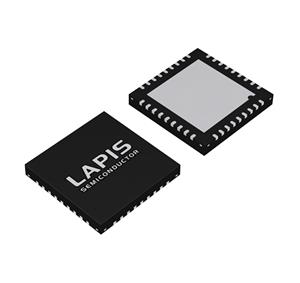LAPIS Semiconductor’s New Multiband Wireless Communication LSI Optimized for Smart Meters World-wide

Yokohama, Japan and Santa Clara, Calif., Nov. 12, 2019 (GLOBE NEWSWIRE) — ROHM Group company LAPIS Semiconductor recently announced the availability of a multiband (sub-1GHz/2.4GHz) wireless communication LSI, ML7421, optimized for applications requiring low power consumption over relatively long distances, such as smart meters, gas/fire alarms, smart agriculture and home/building security systems.In recent years, the worldwide increase of energy usage from natural resources has emphasized the need for improved energy efficiency in order to mitigate the effects of global warming. To address this need, the use of smart meters has increased dramatically in Japan since 2015 and the Wireless M-bus system was launched in Europe. At the same time, there is a trend to collect and manage sensor data using wireless networks not only to optimize energy consumption and lighting in buildings but also for crime and disaster prevention. Furthermore, these wireless sensor networks are becoming increasingly used to improve productivity in agriculture as well.In response, LAPIS Semiconductor developed new wireless communication LSI, ML7421, delivering high-performance communication. In addition to covering the sub-1GHz frequency band (400MHz to 960MHz), it also covers the 2.4GHz frequency band, providing universal compatibility. This LSI has very stable wireless characteristics even under changing environmental parameters such as voltage and temperature fluctuations. Fluctuations over temperature (-40 to +85℃) are only 0.5dB in TX output power and 1.0dB in RX sensitivity. Furthermore, DCDC converter, high-efficiency class-E power amplifier and a high-speed radio wave check function allow the average current consumption to decrease by 15% compared with conventional LAPIS products, leading to lower system power consumption and longer battery life. LAPIS Semiconductor expects that new LSI with low power consumption and world-wide compatibility will be adopted in smart meters and wireless networks around the world. And the company is committed to continuing to simplify wireless device development that contributes to a smarter society.Key Features1. Multiband and stable wireless characteristics and world-wide compatibilityThe ML7421 supports both Sub-1GHz (400MHz to 960MHz) and 2.4GHz. Previously, it was necessary to select wireless LSIs for each country and develop devices for them. By supporting the 2.4GHz band available world-wide, a single device can be deployed globally. Additionally, in environments where communication at 2.4GHz is unstable, long-distance Sub-1GHz communication is available. For this reason, 2.4GHz and Sub-1GHz can be used as bridged communication depending on the application or the environment. The ML7421 can be used in radio stations compliant to ETSI EN 300 200, FCC PART15, and ARIB STD-T66, T67, T108 with several packet handling functions based on Wireless M-Bus and IEEE802.15.4g. Furthermore, this LSI has very stable wireless characteristics even with environmental changes such as voltage and temperature fluctuations. Fluctuations over temperature(-40 to +85℃) are only 0.5dB in TX output power and 1.0dB in RX sensitivity. In addition, improving Delta-Sigma ADCs makes it possible to achieve flexible data rate demodulation up to 300kbps for global usage, while improving receiver sensitivity. As a results, the ML7421 is suitable for equipment used outdoors such as smart meters and various IoT sensors. These stable characteristics make it possible to extend long-range communication further with high power amplifier.2. DCDC converter reduces operating current consumption, and High-speed radio wave check function reduces average current consumptionLow power design technology cultivated over many years allows LAPIS Semiconductor to decrease average current consumption by 15% during the general sensor operation (in 5-second intervals, sleep mode, transmitter(TX) mode and receiver(RX) mode are included). Improving the DCDC converter and the high efficiency class-E Power Amplifier reduces transmitter (TX) mode current consumption down to 27mA at 13dBm output. In addition, high-speed radio wave check function reduces the time required for start-up of reception, minimizing the total time for receiver strength detection (approx. 1ms). As a result, power consumption of wireless nodes within a network are reduced, contributing to overall lower system power consumption and longer battery life.Specifications*BER means Bit Error Rate.Sales Plan Part No.:ML7421Mass Production start: NowMass Production Qty.: 500kpcs/monthPackaging: Tape and reel (2kpcs/reel)ApplicationsSmart-metering (Data collectors, Electricity, Gas, Heat and Water meters)
IoT (Internet of Thing) including energy management systems (HEMS/BEMS/FEMS)About ROHM Group
ROHM Semiconductor, an industry leader in system LSIs, discrete components and module products, utilizes proprietary leading-edge semiconductor technologies along with a completely in-house, vertically integrated production system that allows ROHM to quickly respond to changing needs while ensuring unsurpassed quality and reliability. ROHM has also established a global manufacturing, QA, and sales network in order to deliver stable supply and timely support to customers around the world.AttachmentsWQFN36PressRelease _ML7421_191108+-04Jayme Pontious
ROHM Semiconductor
jpontious@rohmsemiconductor.com
